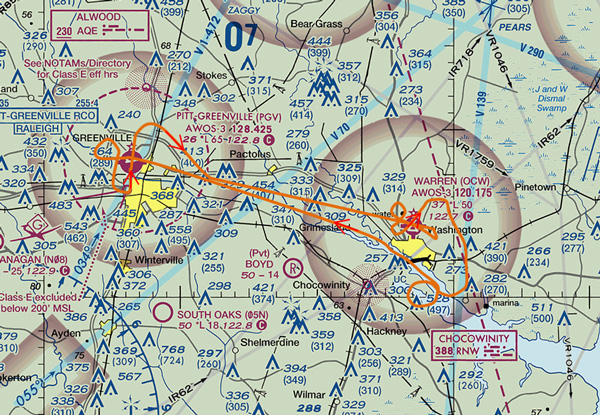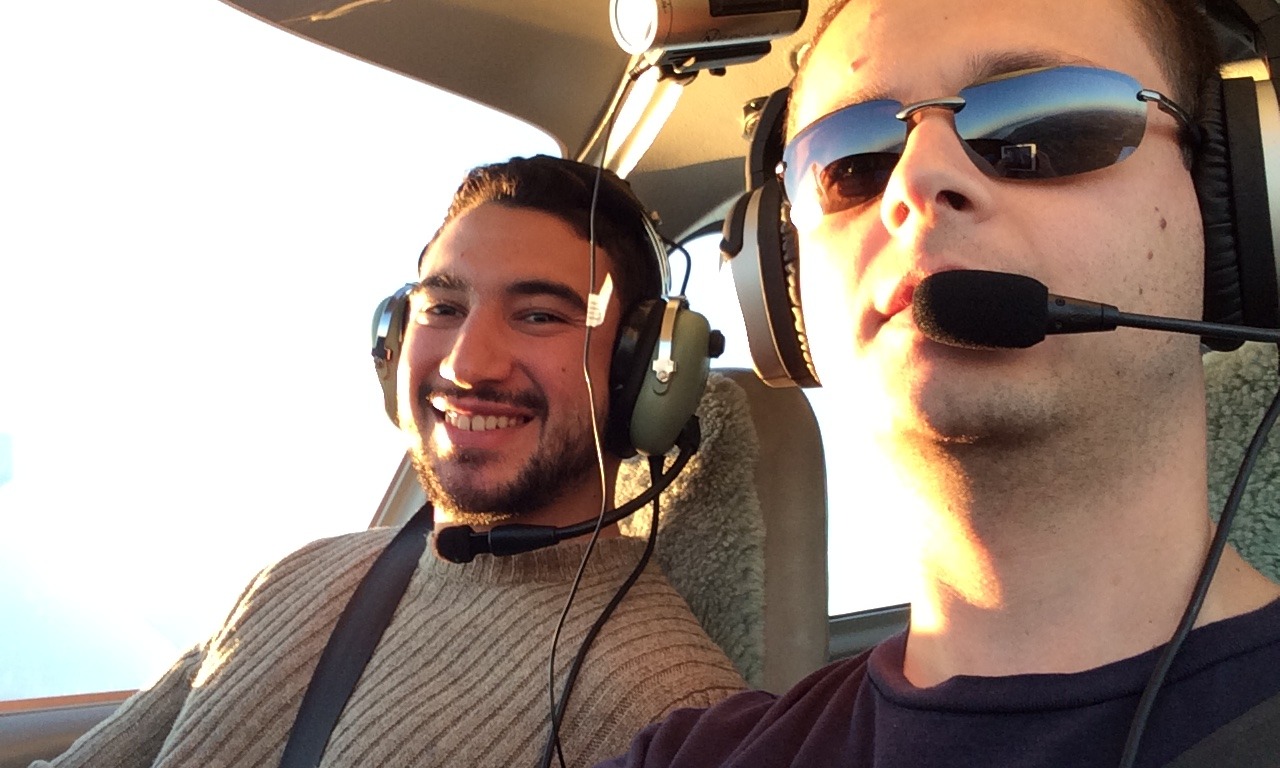On November 15, 2014, I jumped on the plane to do a short flight with two other pilots to Washington, NC (Warren Field – KOCW). This was a pretty cool flight because the “pilot passenger” in the front seat, Chadi, is actually a helicopter pilot, and this was his first ride in a fixed wing with the Garmin G1000 glass cockpit. I truly enjoyed sharing this experience with him!
Jim, who was riding in the back seat, is a fixed wing pilot, but this was also his first time seeing the G1000 in action. Chadi and Jim had never been in a Diamond DA-40 before, so it was cool to share with them the Diamond experience!
It wasn’t until I watched the video at home that I realized how much Chadi enjoyed the plane ride. If you watch the video, you will see a big smile on his face. And seeing that puts a big smile on my face, too! It’s really nice to give a ride to people who enjoy and appreciate flying as much as I do!
Below is the estimated (not actual) flight path from this flight. We departed KPGV, flew over KOCW, then turned around, flew over KOCW again and entered the pattern for runway 5 for a touch-and-go. We then flew over the water, did a 360 degrees steep turn to get a good view of the houses by the water that were under us, and proceeded back to KPGV for a full stop landing on runway 2.

Estimated flight path from KPGV to KOCW and back to KPGV.
In the video you will hear Chadi and Jim saying “five by five” when they are testing their communication. This was the first time I heard this response while doing communication checks so it prompted me to look for more details about it. The information below was extracted from Wikipedia.
The term has its origins in the Q code used for commercial radiotelegraph communication, and later adopted by other radio services, especially amateur radio. The first number is the answer to the question “How do you receive me?” (Q code QRK), typically answered with “I am receiving (1–5)” where 1 is unreadable and 5 is perfect. The second number is the answer to the question “What is the strength of my signals?” (Q code QSA), typically answered with “The strength of your signals is … (1 to 5).”. “5 by 5” was the answer to the QRK/QSA questions to indicate the best quality signal. “5 by 5” being the best quality was applied to other things by analogy.
In voice procedure (the techniques used to facilitate spoken communication over two-way radios) a transmitting station may request a report on the subjective quality of signal they are broadcasting. In the military of the North Atlantic Treaty Organization (NATO) countries, and other organizations, the signal quality is reported on two scales: the first is for signal strength, and the second for signal clarity or “readability.” Both these scales range from one to five, where one is the worst and five is the best. The listening station reports these numbers separated with the word “by”. “Five by five” therefore means a signal that has excellent strength and perfect clarity — the most understandable signal possible.
“Five by five” (occasionally written “‘5 by 5”, “five-by-five”, “5 × 5”, “5-by-5” or even just “Fives”), by extension, has come to mean “I understand you perfectly” in situations other than radio communication. Further shortened forms are “five by”, “fivers” and “fifers”. Post-World War II, the phrase “loud and clear” entered common usage with a similar meaning.
The term is arguably derived from the signal quality rating systems such as shortwave’s SINPO code or amateur radio’s RST code. Given that this slang spans not only generations but also a spectrum of communications technologies (spark-gap transmitters, shortwave, radio telephone, citizen’s band (CB) radio, cellular among others) and organizations (hobbyist, commercial, military), there are many interpretations in popular misuse.
This reporting system is not appropriate for rating digital signal quality. This is because digital signals have fairly consistent quality as the receiver moves away from the transmitter until reaching a threshold distance. At this threshold point, sometimes called the “digital cliff,” the signal quality takes a severe drop and is lost. This difference in reception reduces attempts to ascertain subjective signal quality to simply asking, “Can you hear me now?” or similar. (The only possible response is “yes”; otherwise, there is just dead air.) This sudden signal drop was also one of the primary arguments of analog proponents against moving to digital systems. However, the “five bars” displayed on many cell phones does directly correlate to the signal strength rating.
YouTube Link: https://youtu.be/3BzJQVhsuF4

